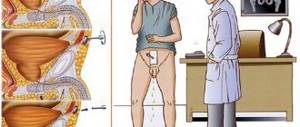Not so long ago, patients diagnosed with enuresis were prescribed only drug therapy or major surgery. However, medicine does not stand still, and new methods of getting rid of the disease are constantly emerging. Laser treatment for urinary incontinence is gradually gaining popularity. This technique has many advantages; it is quite simple and painless. However, before carrying out such therapy, it is necessary to study all its features and weigh the pros and cons.
Laser treatment of urinary incontinence. Source: vseoperacii.com
The symptoms of enuresis are quite pronounced. Patients experience frequent urge to urinate, and urine leaks involuntarily during sleep. This pathology often worries women and elderly patients. Laser treatment of urinary incontinence in women and men will be effective in the following forms of the disease.
- Stressful or psychological enuresis. The patient may experience increased intra-abdominal pressure due to excessive physical activity, coughing and sneezing, laughing, and other normal activities. These causes are not dangerous and can be quickly eliminated.
- Urge form of the disease. With this pathology, the urge to urinate occurs very suddenly, and the process of urine output is almost impossible to control.
- Mixed form of the disease. The disease combines the symptoms of the above-described types of disease.
- Nocturnal enuresis. The urge to uncontrollably urinate occurs exclusively during sleep, at night.
At the initial stage, the disease can be cured by simple training of the MP muscles. The patient is advised to create a schedule for going to the toilet and strictly adhere to it. Even if you really want to go to the toilet, you need to try to restrain yourself. Women need to do Kegel exercises, undergo physical therapy, and take medications. Surgery is prescribed only if all of the above methods are ineffective.
Laser treatment of urinary incontinence is most effective if the disease was caused by stress or psychological discomfort. Also, indications for this procedure may be atony of the pelvic floor muscles.
Causes of stress urinary incontinence
The etiology of stress urinary incontinence is not fully understood, although risk factors are known to include pregnancy and vaginal delivery, menopause, cognitive impairment, obesity and old age.
It has also been proven that damage to the pelvic floor muscles during natural childbirth can lead to loss of strength and nerve sensitivity of the pelvic muscles. These injuries can cause stress incontinence (coughing, sneezing, laughing, running, etc.), impaired pelvic floor support, and lead to pelvic organ prolapse. Prolapse is a condition where organs such as the uterus fall out or slip out of place. Pelvic organ prolapse is often associated with stress urinary incontinence. And although these conditions are often concomitant with each other, one of them may be mildly developed or asymptomatic.
Choose a specialist
Klekovkina Olga
Obstetrician-gynecologist
Read moreMake an appointment
Klimenko Irina
Obstetrician-gynecologist
Read moreMake an appointment
Registration online
For your convenience, we offer to fill out a health questionnaire remotely. By the time you arrive, the file will have already been printed and all you have to do is sign it.
Also on the page with the questionnaire you can familiarize yourself with the contract for the provision of services and other documents that will need to be signed during your visit to the clinic. This will reduce the time spent familiarizing yourself with and filling out documents at the clinic.
Fill out documents online
Special offers
Don't be afraid to ask for help
Despite the widespread prevalence of stress urinary incontinence among both older and younger women, which causes a decrease in quality of life, many women do not seek medical help. Although patients are forced to constantly use pads, sometimes even diapers, suffer from virtually no sex life, and avoid social events because they smell of urine (as they think), this is extremely rarely a complaint when visiting a doctor.
According to recent statistical surveys, only 15% of women over the age of 40 have consulted a doctor with these problems. Many patients do not seek help out of shame, lack of knowledge about possible treatments for involuntary urination, or fear that surgical treatment will be required. Statistics show that better information about non-invasive (non-surgical) treatment methods would lead to an increase in the number of patients willing to seek help without fear of surgery.
Advantages of the method
The process is carried out on an outpatient basis and does not take much time. The procedure is carried out in two stages, each lasting 20 minutes. The doctor who will carry out the treatment must set the parameters of the laser treatment, taking into account sensitivity to temperature for each patient separately. The treatment does not require special preparation, and there is no need for rehabilitation afterwards. Exposure to laser does not affect the performance or control of vehicles. The only restriction is that after the procedure you cannot have sexual intercourse for about 7 days. Benefits of laser exposure:
- effectiveness;
- reliability;
- painlessness.
Return to contents
How to treat urinary incontinence
Non-surgical methods
For most women with urinary incontinence, initial treatment includes a variety of non-invasive methods, such as behavioral therapy and pelvic floor exercises. Such methods require patience, motivation and time. They give their results only with regular, long-term use. A survey of patients showed that the likelihood of regularly performing exercises for the pelvic floor muscles is extremely low, with the exception of a short postpartum period or in the presence of severe urinary symptoms.
Other nonsurgical treatments include electrical stimulation, vaginal cones, occlusive and intravaginal devices, and pharmacologic treatment. These methods are practically not used in widespread practice due to their considerable labor intensity, inconvenience, duration of treatment and rather dubious results.
Surgical methods
Surgical methods are a very common, safe and effective option, although they are more invasive, have more complications and require a long recovery period. There is not enough evidence to compare surgery to non-invasive incontinence treatments, however, most experts recommend starting treatment with non-surgical options.
TREATMENT OF URINARY INCONTINENCE IN WOMEN AT GMTClinic – CHOOSE THE BEST!
Treatment of urinary incontinence in women at the Clinic of German Medical Technologies is carried out in several stages. After a thorough and competent examination using the latest instrumental and laboratory diagnostic methods, the doctor determines an individual treatment plan.
The choice of treatment methods for urinary incontinence will depend on the patient’s age, the severity of the problem and the anatomical features of the pelvic organs.
Since the main goal of the Clinic is to improve the quality of life, in our work we practice only an individual approach and use unique complex schemes, which allows us to achieve a complete cure with long-term fixation of the result.
Experienced GMTClinic specialists, at the highest European level, treat urinary incontinence after childbirth, injuries, and surgeries, after which they recommend a set of preventive measures to strengthen the pelvic muscles.
Sign up for a consultation and treatment with GMTClinic professionals to forget about discomfort forever, live an active life and regain self-confidence!
Please note that appointments with Olga Fedorovna Klekovkina are not available for primary patients.
, due to the doctor’s full workload. We apologize for any inconvenience!
IncontiLase is a painless and effective treatment for stress urinary incontinence.
IncontiLase is an innovative laser procedure for the treatment of early stages of stress urinary incontinence , with or without prolapse. This procedure effectively improves urinary incontinence symptoms, pelvic floor muscle strength, and quality of life, helping to avoid or delay surgery.
How the method works
The principle of laser operation is that laser irradiation changes the bonds of collagen (collagen is a fibrillar protein that forms the basis of vaginal tissue). The amount of collagen in patients with urinary incontinence and genital prolapse is reduced. Collagen under the influence of a laser is reduced by 2/3 of its length compared to the state before the procedure.
How does the procedure work?
The IncontiLase procedure consists of 2 phases: after appropriate antiseptic treatment of the patient's vagina, a laser reflector is installed to direct the laser beam delivery system (fractional handpiece) precisely to the anterior vaginal wall. As a result of exposure to laser energy, a thermal effect is generated, which causes contraction of collagen in the vaginal mucosa. The 2nd phase is performed in the area of the vaginal vestibule only using a fractional manipulator.
On average, the procedure takes 25 minutes. No anesthesia is used during the procedure. There may be minor mild pain or a burning sensation, which disappears immediately after stopping the procedure. The ability to work is not lost after the procedure.
Procedure process
Laser treatment involves influencing the walls of the vagina and the urinary canal with a laser pulse. To do this, a hollow metal vessel with vertically located ribs is inserted into the vaginal cavity. This device is called a manipulator. A laser head is inserted into it, through which the laser pulse passes. The soft tissue of the vagina is exposed to an erbium laser, which has a temperature and mechanical effect. To uniformly treat the entire surface, the handpiece is moved in a circle using laser waves. The impact is carried out on collagen fibers that have lost their elasticity, making them more toned and dense. The action of the laser stimulates cells to produce collagen.
After the procedure, the soft tissues become tightened and, as a result, urinary incontinence stops.
Return to contents
Minuses
This method also has disadvantages, which include:
- The need for several sessions . Improvements occur after just 1 treatment session, but to consolidate the effect, 3 such procedures are required with an interval of 1 month (if the degree of pathology is high, you will have to undergo 5 procedures).
- High price . 1 session of laser treatment for urinary incontinence costs from 15,000 rubles. For the entire course you will have to pay a minimum of 45,000 rubles, to this amount the cost of tests and appointments with a gynecologist is also added.
- Restrictions after the procedure . After the treatment procedure, the patient can immediately return to everyday activities, but there are still some restrictions (described below). They should be followed so that the effect of treatment does not disappear.
- The need for maintenance therapy . 2 years after the course of treatment, it should be repeated again to prevent incontinence. And this entails additional costs.
Contraindications
Laser therapy is contraindicated for:
- Diabetes mellitus.
- Acute inflammatory and infectious pathologies (especially in the genital area) and respiratory diseases.
- Dermatological diseases.
- Blood diseases, bleeding and tendency to them.
- Oncological diseases.
- Pregnancy.
- Menses.
- Obesity (BMI > 33).
Before the procedure, it is necessary to undergo the following tests : oncocytological smear, flora smear, general urine test and ultrasound of the abdominal organs to exclude contraindications. A woman’s work should not involve heavy lifting, otherwise the effect of the procedure may be zero.
pros
Laser treatment for urinary incontinence has great advantages:
- Non-invasive . Laser treatment is non-surgical, that is, it does not involve cutting tissue, suturing or other surgical procedures.
- Painless . During the procedure, the patient does not experience any pain. In addition, the method does not even require anesthesia.
- No special training required . Before the treatment session, you only need to pass a set of tests; special preparation (for example, diet or sexual abstinence) is not needed.
- Speed . The procedure lasts from 15 to 30 minutes, depending on the degree of incontinence and the individual characteristics of the patient’s body.
- No recovery period . After the session, the patient does not need to take anti-inflammatory and painkillers, she can immediately go about her business.
- High efficiency . Improvements occur after 1 procedure and intensify over the next 6 months. After the full course of treatment, 70% of women who underwent laser therapy completely disappeared from symptoms of urinary incontinence, and 94% of women noticed a significant reduction in symptoms of pathology.
- Aesthetic effect . The laser method not only has a therapeutic effect, but also helps solve aesthetic problems: the overall tone of the vaginal muscles increases and the condition of the skin improves. Menopause begins to proceed much easier.
- Suitable for various types of incontinence . Laser treatment is effective for stress, urge, mixed and nocturnal incontinence. Stress and urge incontinence can be cured in 3 sessions; mixed incontinence may require more procedures.











